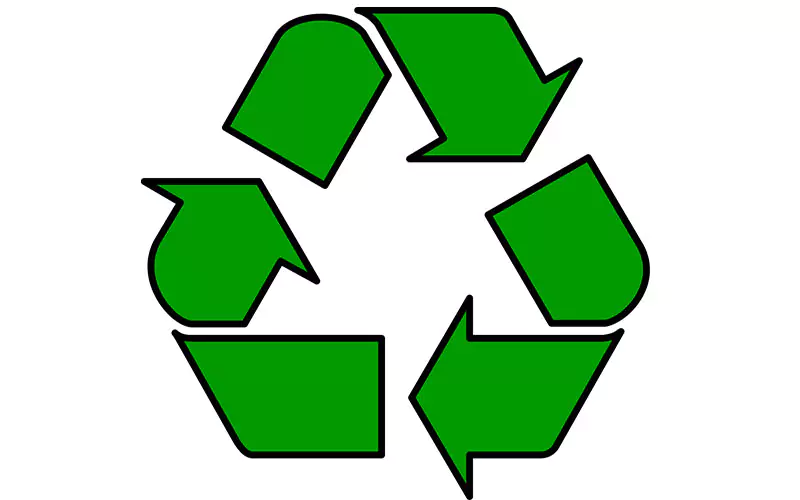By Liz Stevens and Dianna Brodine, UV+EB Technology
In early February, Michael Regan, President Biden’s nominee for EPA administrator, spoke directly to plastics pollution during his Senate confirmation hearing. In a comment acknowledging the need to address single-use plastics, he said plastics are a concern, “especially the impacts that we’ve seen with our marine life and our coastal communities,” and encouraged a “close look” at proposals currently in front of the EPA aimed at reducing single-use plastic.
It didn’t take a Senate hearing to confirm that sustainability and recycling in consumer goods manufacturing and packaging are big and only getting bigger in the US and across the globe. From consumers to brand owners to material suppliers, everyone is paying attention.
Big consumer brands leading the way
Among the big food, beverage and cosmetics makers, and the giant retailers like Walmart and Target, there is increasing pressure for products that are produced and packaged with sustainability in mind.
At the start of 2020, Nestlé S.A., the largest food company in the world, committed roughly $2.24 billion US dollars over the next few years toward creating a circular economy for plastics, reducing its use of virgin plastic in packaging and funding environmental cleanup efforts. Acknowledging that food-grade plastic packaging is difficult to recycle and that it is therefore in limited supply, Nestlé is leading the charge toward recyclables by working on sourcing and investing in millions of metric tons of food-grade recycled plastics.
Nestlé also conducts research at its own Institute of Packaging Sciences, and is exploring new materials, refill systems and recycling solutions. In addition, the company has promised to invest $280 million USD in start-up companies that focus on sustainable packaging.
Cosmetics giant L’Oréal is one of the major brands that has joined the US Plastics Pact, an organization of more than 60 brands, retailers, government agencies and more (RadTech International North America also is a member), committed to creating a circular economy for plastic in America. As a member of the organization, L’Oréal USA aims to make all of its plastic packaging in the nation reusable, recyclable or compostable by 2025.
Danielle Azoulay, head of CSR and sustainability at L’Oréal USA, stated that the company is committed to doing its part while acknowledging that its own global sustainability commitment, L’Oréal for the Future, which launched in 2020, “will reach its full potential through collaboration – across our entire value chain, our industry and beyond it.”
The big retailers also are setting new standards that packaging printers are obligated to meet. Target, for example, uses the EPA’s Greener Living Sustainable Packaging Program as its standard for avoiding the use of chemicals of high concern in packaging and for increased use of recycled or renewable content. At Walmart, the call is for safe, affordable, recyclable and optimized packaging that includes sustainable materials.
Sustainability players in the supply chain
It is not just the big retailers that are seeking advancements, nor just the titans of consumables and cosmetics that are tightening up their production processes and revamping their product lines. Substrate manufacturers, pigment and ink producers, and labeling/packaging makers now are among industry’s sustainability and recycling champions.
Verstraete IML, a Belgium-based company, take sustainable development very seriously. In addition to optimizing its own operations for sustainability and to minimize waste, Verstraete’s in-mold labels and packaging – for injection molding, blow mold and thermoforming – are made of fully recyclable material.
Verstraete IML was elected as a member of the HolyGrail 2.0 Leadership team, a project that includes 28 cross-country partners, supported by the Ellen MacArthur Foundation. The goal: achieve a truly circular packaging economy. The HolyGrail 2.0 partners have investigated the use of chemical tracers or digital watermarks to tag plastic for better sorting and recycling. With a proof-of-concept success achieved, the partners now will move on to launching an industrial pilot project for digital watermarking.
BASF, the second largest producer and marketer of chemicals and related products in North America, wears its environmental philosophy on its sleeve. Prominently displayed on the company’s website is a simple statement: At BASF, we create chemistry for a sustainable future.
BASF’s Colors & Effects brand has developed Sicopal® Black K 0098 FK, a sustainable alternative to replace carbon black. Noting that recyclability now is a decisive factor for plastics design, the Colors & Effects R&D team developed this NIR-reflective alternative with a pigment that allows for reliable detection of recyclable plastic at materials recycling facilities. Reacting to consumer desires, the Colors & Effects brand now also includes a special pigment portfolio that can be used to create compostable colored plastics and printing inks. Industrial composting is one of the solutions for dealing with end-of-lifecycle products and packaging, allowing them to be diverted from landfills and incinerators.
Kansas-based Nazdar Ink Technologies, a manufacturer of UV curing, water-based and solvent-based screen printing, inkjet and narrow web inks, has seen UV curing evolve in the last few years toward greater sustainability. Advancing beyond traditional UV curing technologies, the company sees UV LED as becoming a preferred technology due to its reduced energy consumption and lower ventilation requirements.
Nazdar, in turn, has modified its existing inks and created new inks, many of which are compatible with LED equipment, to effectively meet new sustainability guidelines. Josh Lutz, Nazdar market segment manager-UV digital, notes that “UV inks are ideal in terms of sustainability, as they have only trace amounts of volatile organic compounds (VOCs).”
At Sun Chemical, sustainability in the production of pigments, inks, coatings and more is addressed in several ways. The company has a new series of energy-curable inks for primary and secondary food packaging that is not manufactured with Bisphenol A (BPA)-based materials and meets low migration specifications, according to its website. These inks meet the latest photoinitiator safe packaging guidelines and provide low odor and very low residual extractables characteristics. Sun Chemical also has created a deseamable adhesive for use on labels for rPET bottles, allowing the labels to be removed easily during the bottle wash step of the recycling process.
RadTech steps forward
As sustainability issues gain visibility, RadTech has stepped forward to support its membership. Todd Fayne, Sustainability Committee Co-Chair for RadTech International North American and Associate Director, Global Snacks R&D at PepsiCo, discussed RadTech’s efforts, “The first task was to poll RadTech’s membership and understand what was being asked of the industry; then, we needed to organize that input into something actionable,” Fayne said. “Our mission will be to start delivering bite-size reports to the membership on the current state of affairs of UV/EB materials’ impact on end-user sustainability goals, with a future eye toward providing pathways toward improving UV/EB industry’s participation in this massive shift that is underway in many industries.”
The focus today, said Fayne, is overwhelmingly on the flexible packaging segment due to its ubiquity and visibility to consumers and regulators. “Energy-curable products already are very green, being generally solvent-free and low-energy in their application,” he explained. “The concentration now is on curing technology’s impacts to recyclability, composting and other initiatives on which the broader plastics and packaging industries are focusing.”
Next steps for RadTech include a deeper dive into quantifying the benefits of the technology. “I feel that most of the membership have the basics down when selling UV/EB to new users and brand owners,” said Fayne, “We are going to work hard on expanding that knowledge base by adding as many arrows to the quiver as possible as the focus on circular economy impacts the broader industries in which our membership thrives. These will include questions around regulations, certifications and performance of general UV/EB chemistries.
Conclusion
Sustainability, recycling and the circular economy now are more than just trends. They have become foundational pillars for many companies, ranging from the largest of the consumer brands to the smallest mom-and-pop shops. The challenge will be in adapting existing processes and technologies to meet the demands of the circular economy – while also acknowledging the pervasiveness of plastics in packaging for reasons of safety, convenience and cost.
Sources
- Nestlé Creates Market for Food-Grade Recycled Plastics, Launches Fund to Boost Packaging Innovation,” https://www.packworld.com/home/article/21111161/nestl-nestl-creates-market-for-foodgrade-recycled-plastics-launches-fund-to-boost-packaging-innovation
- “L’Oréal Joins U.S. Plastics Pact,” https://www.beautypackaging.com/contents/view_breaking-news/2020-08-25/loreal-joins-us-plastics-pact/
- “L’Oréal for the Future, our sustainability commitments for 2030,” https://www.loreal.com/en/commitments-and-responsibilities/for-the-planet/
- News, DEC 10 2020, “Verstraete IML’s SealPPeel wins Plastic Recycling Award Europe,” https://www.verstraete-iml.com//en
- News, SEP 09 2020, “Verstraete IML elected as member of the HolyGrail2.0 Leadership Team,” https://www.verstraete-iml.com//en
- News Release April 28, 2020, “Colors & Effects® developed Sicopal® Black K 0098 FK for smart recycling of dark plastics.”
- News Release August 20, 2020, “Colors & Effects® supports sustainable packaging with pigments for compostable plastics and printing inks,” https://d1xdtocjulrb4e.cloudfront.net/BASF-Colors-Effects_Pigments-for-compostable-plastics-inks.pdf
- Roxi Laura Patriquin, lpatriquin@nazdar.com
- “Understanding the Role of Inks in Sustainability,” https://www.packagingstrategies.com/articles/95253-understanding-the-role-of-inks-in-sustainability







